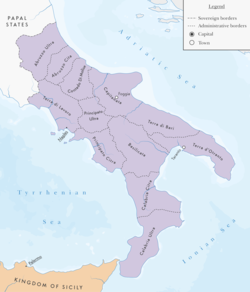
Back Königreich Neapel ALS Reino de Nápols AN مملكة نابولي Arabic مملكة نابولى ARZ Reinu de Nápoles AST Neapol krallığı Azerbaijani Неапалітанскае каралеўства Byelorussian Неаполитанско кралство Bulgarian Rouantelezh Naplez Breton Napuljska Kraljevina BS
Kingdom of Naples
| |
|---|---|
| |
| Motto: Noxias herbas (Latin)[b] Noxious herbs | |
 The territory of the Kingdom of Naples in 1454 | |
| Status |
|
| Capital | Naples |
| Official languages | |
| Religion | Roman Catholicism |
| Demonym(s) | Neapolitan |
| Government | Feudal absolute monarchy |
| King | |
• 1282–1285 | Charles I (first) |
• 1815–1816 | Ferdinand IV (last) |
| History | |
| 1282 | |
| 31 August 1302 | |
| 7 July 1647 | |
| 7 March 1714 | |
| 10 March 1806 | |
| 8 December 1816 | |
| Population | |
• c. 1600 | 3,000,000[2] |
| Currency | |
| Today part of | Italy |
The Kingdom of Naples (Latin: Regnum Neapolitanum; Italian: Regno di Napoli; Neapolitan: Regno 'e Napule) was a state that ruled the part of the Italian Peninsula south of the Papal States between 1282 and 1816. It was established by the War of the Sicilian Vespers (1282–1302), when the island of Sicily revolted and was conquered by the Crown of Aragon, becoming a separate kingdom also called the Kingdom of Sicily.[3] This left the Neapolitan mainland under the possession of Charles of Anjou. Later, two competing lines of the Angevin family competed for the Kingdom of Naples in the late 14th century, which resulted in the death of Joanna I by Charles III of Naples. Charles' daughter Joanna II adopted King Alfonso V of Aragon as heir, who would then unite Naples into his Aragonese dominions in 1442.
As part of the Italian Wars, France briefly ruled the territory in 1494 and at the beginning of the 16th century; it then went to war with Spain over the kingdom in 1502, a conflict that ended in a victory for Ferdinand II, who was in full control of the kingdom by 1504. The Spanish held control of Naples throughout the 17th century where it remained an important source of economic and military power for the Spanish Crown. After the War of the Spanish Succession in the early 18th century, the possession of the kingdom again changed hands; the 1714 Treaty of Rastatt saw Naples given to Charles VI of the Austrian Habsburgs. However, Naples and Sicily were conquered by Charles, Duke of Parma (of the Spanish Bourbons) during the War of the Polish Succession in 1734, he was then installed as King of Naples and Sicily from 1735. In 1816, Naples formally unified with the island of Sicily to form the Kingdom of the Two Sicilies.
The Kingdom of Naples was one of the largest and most important Italian states throughout all its history. Its territory corresponded to the current Italian regions of Campania, Calabria, Apulia, Basilicata, Abruzzo, Molise, and also included some areas of today's southern and eastern Lazio.[4]
Cite error: There are <ref group=lower-alpha> tags or {{efn}} templates on this page, but the references will not show without a {{reflist|group=lower-alpha}} template or {{notelist}} template (see the help page).
- ^ Summonte, Giovanni Antonio (1675). "Dell'Historia della città, e regno di Napoli". Archived from the original on 26 March 2015.
- ^ Hanlon 1997, p. 50
- ^ Fremont-Barnes, Gregory (2007). Encyclopedia of the Age of Political Revolutions and New Ideologies, 1760–1815. Vol. 1. Greenwood. p. 495. ISBN 978-0-313-33446-7.
- ^ Galasso, Giuseppe. Il regno di Napoli: Il Mezzogiorno angioino e aragonese, 1266–1494 (in Italian). UTET.

